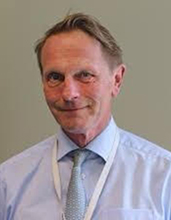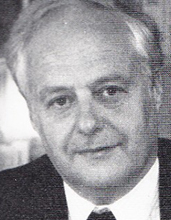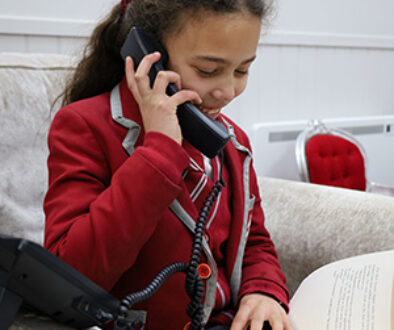Absent Friends
Following the recent deaths of former CISC colleagues Adrian Aylward and Patrick Tobin, we publish two moving obituaries, both penned by Giles Mercer.
May Adrian and Patrick rest in peace.
ADRIAN AYLWARD
 The death of Adrian Aylward on Maundy Thursday from cancer saw the passing of a titan of Catholic education and a wonderful family man, loved and mourned by very many friends. His wife, Caroline, gave him enormous love and support and their three children, Molly, Joseph, and Freya, were the joy of his life.
The death of Adrian Aylward on Maundy Thursday from cancer saw the passing of a titan of Catholic education and a wonderful family man, loved and mourned by very many friends. His wife, Caroline, gave him enormous love and support and their three children, Molly, Joseph, and Freya, were the joy of his life.
From Worth and Oxford, Adrian worked successfully in the City, while discovering his vocation as a teacher. He taught Religious Education at Downside, where he was appointed to the senior leadership team with responsibility for marketing and admissions; a shrewd appointment during a challenging time for boarding education caused largely by the recession of the early 1990s.
It was inevitable that he would gain a headship, which he duly did at Stonyhurst, from 1996 to 2006. There, he unflinchingly steered the College through the immense difficulties arising from challenging and complicated abuse scandals, handling outside agencies with consummate skill. He subsequently led the school to full co-education, a complex achievement in itself. Throughout, he cared for the whole community, boys and girls and their families, teaching and support staff, the Jesuit community, and wider, local communities. Countless individuals, especially the young, received his kindness. Despite all challenges, Adrian enabled Stonyhurst to blossom under his leadership, and stand proud.
Having served most effectively on the CISC committee, Adrian was elected Chair of CISC from 2005 to 2010. From Stonyhurst he moved to Leweston, where he led the school with clarity of vision and his trademark energy, motivating and inspiring all, not least recruiting pupils with his inimitable mixture of realism and charisma.
More recently, he served as a governor at Downside from March 2012, being elected the first lay Chair of Governors in January 2018. Combining determination and sensitivity, team-work and leadership, Adrian guided the drive to separate the school and monastery and establish a new trust, to the benefit of all at Downside, while ensuring the Benedictine character of the school remained its well-spring. He worked prodigiously hard and with that exceptional ability, seen throughout his career, of identifying clear priorities and bringing others with him towards agreed goals.
Adrian gave a lifetime to Catholic education and did so with dynamism, flowing from a deep interior spirit, and often with a carefree obliviousness of his attire or the state of his spectacles. Adrian loved being among people and his generous sociability into the late hours at CISC conferences entered legend, without this ever preventing an inspirational address to the troops with authority and professionalism the following morning. His resonant, rather emphatic voice, together with a delicious sense of humour, added to his influence – and a massive influence for the good at that – which was combined with a certain steel when needed and a readiness never to duck the hard decisions wherever the Lord called him to make them.
Adrian was devoted to Lourdes. He loved family and friends. He enjoyed tennis and golf, but above all loved fishing, having spent most of his childhood on the rivers in Ireland. As Caroline said, ‘it was his time for thinking and not thinking, being immersed in nature’. He believed passionately that lay Catholics must use as fully as possible the responsibilities entrusted to them at Baptism. This was a remarkable man, a good and faithful servant of the Lord. May he rest in peace, and may the same Lord comfort Caroline and their family in the sadness of their loss.
PATRICK TOBIN
 On the last assembly of the school year in 1989 the deputy headmaster, Wilfred Hammond, sprang a surprise on Patrick Tobin and paid the following tribute to the outgoing headmaster. There could be no better summary of the achievements at Prior Park of Patrick Tobin as headmaster (1981-1989), wonderfully supported and enhanced by his wife Margery. I make no apology, therefore, for reproducing it at some length with the agreement of the author.
On the last assembly of the school year in 1989 the deputy headmaster, Wilfred Hammond, sprang a surprise on Patrick Tobin and paid the following tribute to the outgoing headmaster. There could be no better summary of the achievements at Prior Park of Patrick Tobin as headmaster (1981-1989), wonderfully supported and enhanced by his wife Margery. I make no apology, therefore, for reproducing it at some length with the agreement of the author.
Mr Tobin committed himself, and his family, to Prior Park and did so totally. The School did not fall into the terminal decline many people predicted. It did not ‘fold’ as many other Catholic schools did when the religious orders withdrew. Instead it underwent an incredible renaissance. Mr Tobin changed the day, the curriculum, the House and tutorial system, changed structures, changed standards, changed expectations, changed image. He insisted, uncompromisingly, on the highest standards of effort, conduct, courtesy, honesty, and appearance . . . even when this meant confronting times and trends and being unpopular. He projected confidence in the School and its future, and he inspired it. He won over parents. He won over Prep. Schools. He displayed enormous financial and commercial acumen, for the school cannot exist, let alone develop, unless it pays for itself. He ‘watered the cultural desert’ in his commitment not only to intellectual performance but in his commitment to music, drama, and the arts. And above all, he made sure that the School demonstrated its commitment to the faith not only in worship but in action, in service, in personal and social values, in right relationships, and in committed work for a better world. Mr Tobin drives hard for standards and excellence, but he drives himself hardest of all. I have worked under four headmasters and know of many more, but cannot think of one who has, or could possibly, invest more of himself in the school for which he was responsible. Nor can I think of one to match him for inspiration and vision. The faltering school of 230 is now a strong and established school of nearly 400. I remember a brilliant market research report Mr Tobin produced in 1984, analysing what parents, staff and pupils saw in Prior Park, and what they wanted from it in the future, relating Prior Park’s goals to the likely pattern of boarding and the development of co-education. Out of it he developed a coherent strategy to take the School into the 1990s, carried it through Governors’ meetings, and then steered Prior Park towards and into the co-educational future he planned for it. Thanks to his skill and management the strategy worked. In 1982 he had already introduced sixth form day girls into the School. In September 1985 came day girls at eleven-plus. In September 1986 he introduced girls’ boarding at thirteen-plus. In that year the Priory opened, and the first of the Priory boarders will be in next year’s Upper Sixth. Under Mr. Tobin’s bold and imaginative leadership Prior Park has become the leading coeducational Catholic boarding school in the United Kingdom . . . Far from witnessing the demise of Prior Park, his Headmastership has been one of its Great Ages. Rather than a continuator he has been more like the creator of a new and different school. He has not done it alone. And here I do not mean what he would say – the strong team. There is an old joke that behind every successful man stands an astonished wife . . . but I’m sure that Mrs Tobin isn’t at all astonished by her husband’s achievements. Her own contribution to that success, as he would be the first to acknowledge, has been enormous. He would say that his achievement would have been impossible without her. Their home and family have been at the centre of this lay School. Mrs Tobin has been immensely wise, strong, gracious, and resilient. She has been an excellent teacher in her own right and I know that the Modern Languages Department will be saying their own thank-you. And, of course, she has been an important and formative influence in the development of co-education . . .
Sometimes the last people to really see the true worth of a headmaster are the pupils themselves. There are obvious reasons for this, such as what good headmasters demand in the way of discipline and behaviour. More fundamentally, pupils often lack the experience and perspective with which to make a judgement. Who was it who talked about ‘the hour of thoughtless youth’? Only later do we see things as they really were. At the time it’s easy to be small-minded. If you want a basis of judgement look around you. Si monumentum requiris circumspice. You see a full school, a happy school, an achieving school. No headmaster could achieve more than that. There could be no more eloquent testimony to any headmaster’s stewardship. Look at each other, look at the School, look at its precarious past and its promising future, and you will see something of the achievement of these last eight years. Being a headmaster is said to drive people to drink, golf, or insanity. It’s done none of these things to Mr Tobin. But it has driven him to Edinburgh, and that’s a pity. May I ask the School to rise and applaud Mr Tobin and his achievement and wish both him and him and Mrs Tobin every possible future happiness and success?
The move to Edinburgh for the Tobin family was brought about by the appointment of Patrick to be principal of Stewart’s Melville College and The Mary Erskine School (MES), a merger of two great Scottish merchant-company schools. Margery taught modern languages at MES.
Those who know Edinburgh will know that its independent schools, fiercely proud of their reputations, are bastions of the city’s establishment, woven into the Church of Scotland (even in the 1980s). That a Catholic should have been appointed to lead two of its bulwarks was in itself a reflection of Patrick’s magnificent achievements at Prior Park and of his educational prowess and strengths of personality, marked by determination, affability, compassion, eloquence, and integrity, with his great asset of Margery alongside him. But it was a breach of the palisades of momentous proportions, as great as appointing Patrick to be the first lay Head at Prior Park (and one of the first lay Heads, if not the first, of any independent Catholic senior school in Britain). Allowing for the great differences of degree, it was akin to the excitement one felt when a Catholic of Irish background, John F. Kennedy, entered the White House.
At meetings of the Headmasters’ Conference (HMC) I was told by colleagues from Scottish schools of the enormous respect and affection in which Patrick was held. His strategic acumen and exceptional pastoral gifts set a benchmark. A pupil we knew at Stewart’s Melville whose father had died in a climbing accident told us how the principal had gone out of his way to help him. With Patrick the grand sweep (and his two great schools had large pupil numbers) never meant he lost the personal touch. I was delighted to appoint to Prior Park one of Patrick’s MES teachers, Mrs Anne Mallon, who was to become a housemistress and whose children joined Prior Park. Anne spoke often about Patrick’s transformative leadership.
When I became head of Prior Park in 1996, I had a sharp appreciation of Patrick’s legacy, as I did that of my immediate predecessor, Jeremy Goulding, whose herculean work in rebuilding the Mansion after the devastating fire was all around (not least my own attractively re-constructed office), not to mention the further increase in the school roll, the further strengthening of co-education, the further enrichments to the wider curriculum, especially music. All heads, while rightly seeking to place their own stamp on a school, cannot but be aware of their predecessors. One inherits a school’s reputation, staff appointments, policies (which were brilliantly initiated by Patrick and Wilfred Hammond and developed by Jeremy, especially the unusually rich PSHE programme or Personal Development Programme as it was called). I was privy to the many files and folders in a large cupboard in the office. How thorough Patrick was. How much I learned from browsing through the volumes of paperwork, such as his notes for assemblies and Speech Day addresses. I marvelled at his persistence and unrelenting energy, which resonated through every page. I was impressed – and amused – by his lengthy correspondence with a member of staff who had not worn the correct clothing for umpiring a junior cricket team. Then there might be a careful follow-up with some housemaster after an evening visit made to the House, pointing out courteously but clearly what was good and what needed to be better. Patrick was right, of course. Detail always speaks volumes. No area of the school should be a no-go area for the boss. No stone should be left unturned. To cut the mustard, leadership has to be by walking around and seeing for oneself.
The truth was I had admired Patrick from afar since teaching at Sherborne School in the early 1980s. I liked the advertisements he placed in The Tablet with a photograph of himself below the Mansion Steps. In promoting Prior Park, he seemed to make its assets go a long way. A colleague and I wondered over a coffee-break whether Prior Park would survive against the odds. Then out of the blue, after my appointment as the first lay Head of Stonyhurst went public, Patrick and Margery invited Caroline and me to dinner in the early summer of 1985. First, he showed us round, exuding enthusiasm, humour, energy, going round the boarding houses, St Peter’s, the Mansion, the Chapel. How well he knew every boy and girl, their academic progress, their wider contributions. How cheerfully and respectfully they responded to him. The buildings clearly needed an overhaul – he made no secret of that (and a rat scurrying across the Mansion floor rather made a point!) – but what mattered to him were people, spirit, expectations, encouragement, the quality of relationships and the community.
He wanted the Chapel to be the living heart of the community. He introduced us to the benignly gifted Fr Paul Edwards. One of Patrick’s recurring themes was that lay Catholics must take full baptismal responsibility in the life of the Church as envisaged by the Second Vatican Council, co-operating with the clergy. A lay Head was not a fall-back or second-best. A lay head had particular gifts to bring to a school community – especially the gifts of marriage and family life, together with the gifts of the spouse and the children – that priests and those in religious life, who had other priceless gifts, could not bring. Patrick was a family man through and through. He put his family at the heart of his life and family-life at the heart of his schools.
His vision was that of the fully co-educational Catholic family school, carefully organised, properly staffed, and appropriately balanced. From that vision he took over the house (the Priory) of the Christian Brothers’ Provincialate and had it converted into a girls’ house. He drove the project, ground-breaking in the Catholic sector, with the bursar, John Leay, directing the works. Anne Hammond (Wilfred’s wife) was appointed founding housemistress. Patrick’s team picked the brains of Bryanston (from which, for example, came window locks to prevent girls getting out rather than boys getting in!). This deep commitment to co-education of the highest quality was shared enthusiastically by Patrick’s successors. When I retired in 2009, I told Patrick that, remarkably, the numbers of boys and girls in the college were exactly equal. He was delighted. Whether it was being the first lay Head or introducing co-education Patrick was a pioneer. Those were uncharted waters and he loved navigating them.
In this enterprise Patrick had the unstinting support of the chairman of governors, Fergus Lyons, and the board. He was greatly supported too by John Bogie, the headmaster of Prior Park Preparatory School, who had played a leading role in ensuring Prior Park’s continuation after the announcement of its closure by the Christian Brothers. Patrick could draw increasingly on some exceptionally able and committed staff.
On that summer-evening tour in 1985 and without intending to do so, Patrick had given me a master-class. A highly convivial dinner followed in Kent House. Paul and Helen Fisher and Richard and Sheila Wells were other, delightful guests. We got home very late. When the headship at Prior Park was advertised in 1995, I felt immediately drawn to apply: the appeal of the place had a good deal to do with Patrick.
The Prior Park Tobin years are beautifully judged in the revised history of the College, The Phoenix (2018) by Peter Cornwell, with additional material by Denis Clarke. More personal – and fascinating too – is Patrick’s memoir, Portrait of a Putney Pud: An Unpredictable Career in Teaching (2004). I urge new teachers at Prior Park to read both – and the finance director to be prevailed upon to buy many copies for the purpose. I would throw in also a classic on teaching, The Learning Game (2000) by Jonathan Smith, Patrick’s good friend at Tonbridge, whose educational approach he shared. Patrick was elected Chairman of HMC in 1998. His address at the annual meeting in Jersey enunciated in his inimitably persuasive way the core purpose of education, characteristically blending sweeping themes with telling anecdotes. In my twenty-four years of headship I had not seen its quality equalled.
Patrick had a formidable intellect and breadth of learning, which he brought to bear on his teaching and headships, but which spread further into a rich mental and emotional hinterland. His read prodigiously and he thought deeply and often about issues that matter. Being shown round Quarr Abbey and Osborne House by Patrick was a joy, but I was unable to keep up with his appraisal of Otto von Bismarck’s strengths and weaknesses, as we walked round the gardens, and had to admit that I had not read the latest magisterial tome by Jonathan Steinberg. He was a frequent letter-writer to The Times and The Tablet. Not long ago we rang each other up to laugh as our letters were side-by-side in The Tablet (and in agreement!). He was a European to his finger-tips. We shared a detestation of Brexit. He and Margery had carried out great work after leaving Edinburgh for HMC Projects in Central and Eastern Europe. They knew these countries well and helped countless young people to come to UK boarding schools and forge lasting friendships and links.
Days before he died Patrick’s book on medieval history was published, The Gong Tormented Sea: the Norman Kingdom of Sicily and the Byzantine Empire: indeed, a copy arrived on my door-mat the day he died. Margery told me he had spent decades developing the book in his mind, though it is refined from up-to-date secondary sources and has a newly-minted freshness about it. His unmistakable voice come through every page: his rare ability to illuminate grandiose themes, such as the tensions between Byzantium and the West or the differing preoccupations of the Latin and Greek Churches, with vivid detail; his dynamic, compelling narrative pace; his references to our own world, such as his stimulating observations on Russia. The marvellous images are ones he and Margery took on their travels across the European Continent. It is a tour de force.
When Caroline, Edward and I came to live in Kent House, we remembered fondly our 1985 visit. Patrick and Margery came to see us in Stonyhurst en route to or from Edinburgh. The Tobin torch was carried in the HMC North-West Division from 1990 by Wilf and Anne Hammond, who in 1990 had gone to St Mary’s Crosby, where Wilf gained the headship. We met regularly. The bursar of Stockport Grammar School, which we knew, was none other than Patrick’s former bursar at Prior Park, John Leay. In the North-East the torch was carried by Paul and Helen Fisher, who had gone in the 1990s to Mount St Mary’s College, the Jesuit school near Sheffield, where Paul was head before taking up the headship of Loughborough Grammar School. We too met regularly. Somehow, Patrick always came up in conversation with all the above. The two older children of Patrick and Margery, Matthew and Emma, completed their schooling at Prior Park after the family moved to Edinburgh, and did so with distinction. The childhood memories of Lucy and Sophie (who was born at Prior Park) were made the happier by their Prior Park years.
Patrick and Margery visited when they could. The regard the past pupils had for Patrick was such that he was invited to be the guest of honour and speaker at their annual dinner in the late 1990s. Especially memorable too was the visit of Patrick and Margery to Speech Day 2016 to mark the retirement of Denis Clarke and his outstanding service to Prior Park, supported by Jennie. Jeremy and Isobel Goulding and Caroline and I were also guests of James and Ali Murphy-O’Connor. A photograph was taken in the grand surroundings of the Mansion of the four heads with Denis (not far, my memory prodded me, from where the rat had appeared!).
The greatest blessing for Prior Park was Patrick’s appointment as its headmaster. But the school benefited enormously from a deeper blessing still, the day Patrick and Margery met. Patrick Tobin was a great teacher, an inspiring educational leader, the prime mover in a Prior Park renaissance, a wonderful family man, the kindest of friends, an unswerving servant of the Lord. May he rest in peace.



